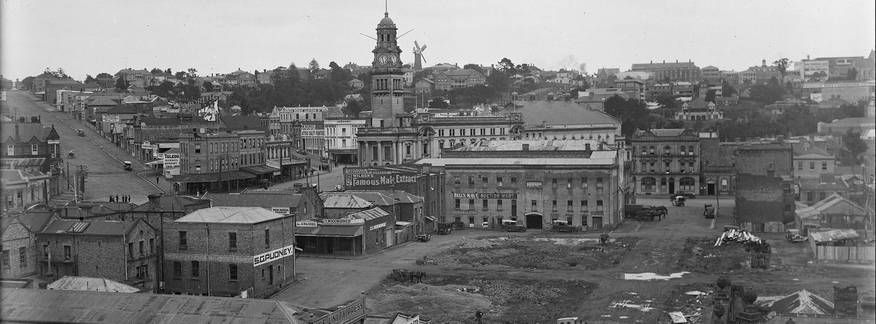Tour Overview
This heritage walk traces the story of Tāmaki Makaurau Auckland’s growth through its built environment. Join us as we explore some of uptown Queen Street’s most iconic buildings and uncover taonga from Ngā Pātaka Kōrero – Auckland Libraries Heritage Collections that tell the story of the city’s layered past.
Early history of this area saw Māori settlement centered around a small stream (Waihorotiu) that was partly navigable by canoe. Māori gardening was recorded in the Queen St valley as late as c.1838-4 while what is now Albert Park housed the large village of Horotiu. Most of the area between Wellesley and Victoria Streets was a flat swampy area which fed into the Waihorotiu creek.
In 1840, Ngāti Whātua of Ōrākei invited English settlers to share the land with them. Te Kawau, their paramount chief, wanted to offer hospitality, but he also wanted to gain some security against other tribes, especially the northern tribes which had muskets. So, in February 1840, Te Kawau and six other chiefs travelled to the Bay of Islands to invite Governor Hobson to come and live with them, partly to seek protection from their enemies. On 20 March, Te Kawau and other chiefs of Ngāti Whātua of Ōrākei signed the Treaty of Waitangi. By September, the British flagstaff was raised on Point Britomart/Te Rerenga Oraiti and Auckland became the capital of New Zealand. To find out more about this historic moment in Tāmaki Makaurau Auckland’s history head on down to the Te Wharekura 117 Quay Street.
During the early years commercial life centered around Shortland Street, Waterloo Quadrant and Princes Street. However, the town of Auckland expanded quickly and following a fire in 1858, development shifted to the Queen Street area. City planners placed emphasis on creating a vibrant cultural and civic space, establishing theatres, art galleries, libraries, and administrative buildings. Now, as the final stages of Te Waihorotiu Station take shape, Queen Street is set to host Aotearoa New Zealand’s busiest train station — a new chapter in its long history of movement and connection.
Starting Point: North side of Lorne Street and Wellesley St E looking back at Tāmaki Pātaka Kōrero | Auckland Central City Library
Parking: Civic Carpark 299 Queen Street. Open from 6am or Victoria Street car park, 30 Kitchener Street
Terrain: This walk is along public roads and includes historical facts about the buildings and the area. Most of the sites are private businesses or homes. Please respect the environment and do not trespass on private property. Neither Auckland Council nor private property owners accept responsibility for any loss, damage, or injury to you or your property arising from use of this tour.
Copyright 2025 Auckland Council. Auckland Council holds all copyrights associated with this tour. You may not copy or reproduce the content of this tour without permission from Auckland Council. Auckland Council has taken every care to ensure that the information contained in this tour is accurate, but accepts no responsibility arising from, or in connection with, your use of this tour and the information contained in it.
[1] Archaeological Assessment: City rail link project
[2] The founding of Auckland. Waitangi Tribunal https://www.waitangitribunal.govt.nz/en/publications/education/orakei/new-section-page-3
Stops
-
Destinations and further information
-
Stop 1: Auckland Central City Library
-
Stop 2: St James Theatre
-
Stop 3: MLC Building
-
Stop 4: Auckland Town Hall
-
Stop 5: Aotea Square and Aotea Centre
-
Stop 6: The Civic
-
Stop 7: Smith and Caughey's
-
Stop 8: Darby Building
-
Stop 9: The Strand Arcade
-
Stop 10: Auckland Art Gallery

